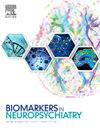GABA dysfunction in schizophrenia: The GABAA receptor as a potential therapeutic target
Q2 Medicine
引用次数: 0
Abstract
Schizophrenia is a complex psychiatric disorder characterized by debilitating positive, negative, and cognitive symptoms, whose etiology is traditionally attributed to dopamine dysregulation. While dopamine receptor antagonists effectively alleviate positive symptoms, they fail to address the persistent cognitive and negative symptom domains of disease. Growing evidence supports a broader neurobiological framework in which cortical excitation-inhibition (E/I) imbalance acts as an upstream contributor to dopaminergic dysregulation in schizophrenia, with the neurotransmitters gamma-aminobutyric acid (GABA) and glutamate playing a critical role in this homeostasis. Herein, we summarize such evidence, including preclinical findings from animal models of schizophrenia that support the role of GABAergic dysfunction in disease pathophysiology and validate the GABAA receptor as a promising therapeutic target. We review the potential of subtype-selective GABAA receptor modulators to restore E/I balance and improve symptoms currently resistant to antidopaminergic agents. Key challenges and considerations for the future development of these therapeutics are also discussed, emphasizing the importance of targeting E/I imbalance to better understand and treat the network-level dysfunction underlying schizophrenia.
精神分裂症的GABA功能障碍:GABAA受体作为潜在的治疗靶点
精神分裂症是一种复杂的精神障碍,其特征是衰弱的阳性、阴性和认知症状,其病因传统上归因于多巴胺失调。虽然多巴胺受体拮抗剂有效缓解阳性症状,但它们无法解决疾病的持续认知和阴性症状领域。越来越多的证据支持一个更广泛的神经生物学框架,其中皮层兴奋抑制(E/I)失衡是精神分裂症中多巴胺能失调的上游因素,神经递质γ -氨基丁酸(GABA)和谷氨酸在这种内稳态中起着关键作用。在此,我们总结了这些证据,包括精神分裂症动物模型的临床前发现,这些发现支持GABAA能功能障碍在疾病病理生理中的作用,并验证了GABAA受体是一个有希望的治疗靶点。我们回顾了亚型选择性GABAA受体调节剂恢复E/I平衡和改善目前对抗多巴胺能药物耐药症状的潜力。本文还讨论了这些治疗方法未来发展的关键挑战和考虑因素,强调了针对E/I失衡的重要性,以更好地理解和治疗精神分裂症潜在的网络水平功能障碍。
本文章由计算机程序翻译,如有差异,请以英文原文为准。
求助全文
约1分钟内获得全文
求助全文
来源期刊

Biomarkers in Neuropsychiatry
Medicine-Psychiatry and Mental Health
CiteScore
4.00
自引率
0.00%
发文量
12
审稿时长
7 weeks
 求助内容:
求助内容: 应助结果提醒方式:
应助结果提醒方式:


